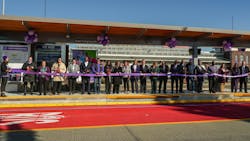IndyGo launches new Purple Line BRT service
The Indianapolis Public Transportation Corporation (IndyGo) celebrated the official grand opening of the Purple Line Bus Rapid Transit (BRT) route after its official launch into service. The agency welcomed special guests and speakers, including Federal Transit Administration (FTA) Deputy Administrator Veronica Vanterpool, Indianapolis Mayor Joe Hogsett, Lawrence Mayor Deb Whitfield and other local dignitaries.
The Purple Line spans 15.2 miles, with 31 stations connecting downtown Indianapolis to the city of Lawrence, Ind.
“To say the Purple Line is simply ‘important’ is an understatement,” said IndyGo President and CEO Jennifer Pyrz. “It represents progress, access, equity and opportunity. Indianapolis has made the decision to invest in transit because we believe in our potential. We know that our city shines when the spotlight is upon us.”
The $188 million project includes $81 million in federal dollars from the FTA.
At the event, local officials also highlighted the broad impact of public transit investments in the city.
“When companies and institutions come to Indianapolis to invest in our city, I can guarantee you that strong transportation infrastructure and transit systems are always on their minds,” said Indianapolis Mayor Hogsett. “We recognize the great value that IndyGo brings to our city.”
“The Purple Line offers Lawrence residents a new connectivity to educational, employment and cultural opportunities in downtown Indianapolis and around the city. I truly believe the Purple Line can bring us closer together as neighbors,” said Lawrence Mayor Whitfield.
The Purple Line has brought crucial infrastructure improvements, economic growth and increased access to opportunities for Indianapolis residents. It will also help to create better connections between downtown Indianapolis and the city of Lawrence by providing faster, more efficient and reliable transportation between many neighborhoods, major employers, healthcare and educational facilities.
